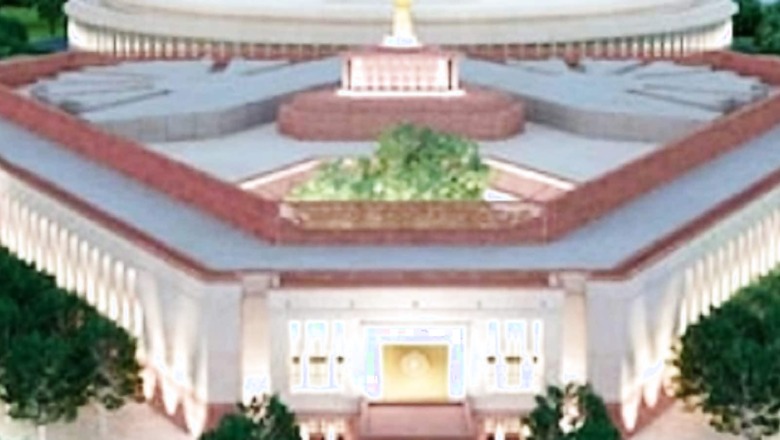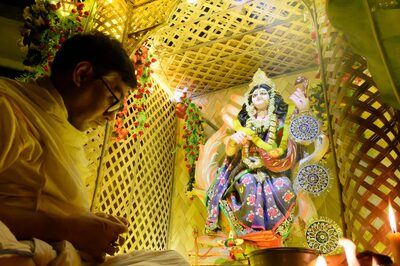
views
Of the two non-office buildings marked for demolition on the Central Vista, the Indira Gandhi National Centre for the Arts (IGNCA) has attracted less love from the protesters than the National Museum. Perhaps because it is harder to defend. At least Rs 100 crore of public money was put into a corpus for a magnificent ode to Indira Gandhi’s love for the arts and yet after 35 years, it has hardly anything to show for all its ambitious plans to be a national hub of culture.
The only one of the original eight buildings planned for the IGNCA by the late American architect Ralph Lerner actually came up on those 25 acres. Even the original ‘temporary’ barracks that once housed the kitchens of the armed forces’, ‘Central Vista Mess’, on that plot beside Rajpath—is still there, besides another Lutyens-era bungalow. That one new IGNCA building has not only had limited footfall but its very concept has been challenged from Day One.
In a scathing analysis in January 1987, days after the winning entry was announced, architect PK Das wrote in The Times of India that Lerner had failed to adhere to the mandatory technical parameters and had not addressed the main stipulation that the design must reflect an ‘Indian ethos’. Das also noted that only a single Indian’s entry (out of the 66 Indians among the 194 architects from around the world who submitted plans) made it to the final shortlist.
While the second prize-winning design of that lone Indian architect—Gautam Bhatia—clearly drew inspiration from our own culture for his design, Das observed that the buildings conceptualised by the three who shared the third prize (all foreigners) could have been set anywhere in the world as there was nothing distinctively Indian about any of them. Lerner’s design too seemed to reflect Lutyens’ style and concept more than anything discernibly Indian.
ALSO READ | Why Moving National Museum to North and South Blocks is a Great Idea
Lerner’s design envisioned a campus of eight buildings: Kala Nidhi (reference library), Kala Kosha (research wing); Sutradhara (administration); Janapada Sampada (tribal and folk art centre); exhibition galleries; an Indian theatre (seating capacity 400); a National Theatre (seating capacity 1200); a concert hall (seating capacity 2000) and a residential block. The only one that ever came up was the first, that too at the Mansingh Road end, not Janpath.
A look at that IGNCA building today is enough to figure out that Lerner’s design shows very little, if any, signs of what he claimed at that time were his inspiration: the traditional styles of Brihadeeshsvara Temple at Thanjavur, Mundeshwari Temple at Ramgarh, Fatehpur Sikri, Keshava Temple at Somanathapura, Mandu, and Lingaraja Temple in Bhubaneswar. The charitable explanation is that the seven buildings that never materialised, would have.
Runner-up Bhatia conceptualised the IGNCA as a series of open-and-partly-enclosed structures along a ‘ghat’, with Rajpath as the metaphorical river. That would presumably have struck a chord among the jury had it comprised more Indians, and perhaps also included people from the performing arts. Whether such a cultural complex would have even seemed appropriate sitting in the midst of an imperial/governmental enclave such as Rajpath is another matter.
One point Das made is especially relevant in today’s context: “Lutyens’ New Delhi is not a city that is in any way expressive of the essence of Indian culture in the way other cities are, be they Old Delhi, Jaisalmer, Jaipur, Varanasi, Haridwar or the temple towns of South India like Madurai.” Then why locate a center that is mandated to showcase, preserve and encourage Indian arts and culture along a Central Vista festooned with soulless Sarkari offices?
But that is so much water under the (metaphorical) bridge as IGNCA was a fait accompli and at least one building was constructed. The question is why the other buildings were not. Given the amount of public money handed over to what miraculously became a private trust headed by Chairperson-for-life Sonia Gandhi just before the Congress lost in 1996, there should have been pressure to complete the project in later years. Instead, there was a conspicuous silence.
That there was no move to complete the landmark complex could possibly be traced back to the Comptroller & Auditor General’s report on IGNCA for 1995-96 to 1998-99. It had come down heavily on the IGNCA’s Building Project Committee that was tasked with constructing the eight edifices for Rs 100 crore (1984 estimates) or Rs 151 crore (1989 estimates). Eventually, the first (and only) building that materialised ended up costing Rs 97 crore!
Unfortunately, in its haste to firewall an institution named after a Mrs Gandhi and headed by another Mrs Gandhi against possible ‘ex-officio’ takeovers, the P.V. Narasimha Rao government had made it a private entity in 1995, agreeing to a decision taken by IGNCA itself. This privatisation cut off its access to more public funds. The Indira Gandhi Memorial Trust also saw most of its activities petering off once it too was converted into a private entity.
Armed with a high court judgment the Atal Bihari Vajpayee government restored the original deed of IGNCA and Sonia Gandhi resigned in 2001. But the Congress came back to power in 2004, so the original ‘team’ also returned. The Prime Minister’s Office then approved the completion of the Kala Nidhi-Kala Kosa buildings, ‘capped’ the Sutradhara building at ground level and gave CPWD the task of doing the needful. Still nothing substantial happened.
Ambika Soni, as culture minister, announced in 2007 that to “restore” IGNCA to its “pre-eminent position for the arts”, Rs. 147.75 crore would be earmarked in the 11th Plan of which Rs 50 crore would be allocated in 2007-08. But instead of restarting a grand project, there was internal backbiting and even a few scams including the abortive attempt in 2011 to hand over IGNCA’s guesthouse to a private player to run as a boutique hotel named Indravan.
ALSO READ | Central Vista Project is No Beauty Contest. Govt Must Care about Its Employees’ Needs
Maybe coalition dynamics of the intervening years made rapid progress on a project named after Indira Gandhi tougher than expected. So the grand IGNCA complex today remains an unloved, single building ensconced in a huge fenced compound, out of bounds for the public except during infrequent events. Even shifting IGNCA’s collections and operations to Janpath Hotel till it gets a new home has been effected with hardly a murmur of protest.
So moving this apparently jinxed complex to a new home on a plot originally allocated to Jamnagar House (and currently occupied by more decrepit barracks) could—and should—become the first step towards reimagining that section of the Central Vista. The “C Hexagon” or the India Gate Roundabout area could become a unique arts and culture precinct, comparable to Trafalgar Square in London or even the Museum Mile in New York.
The hexagon, studded with palaces built by the erstwhile Maharajas, makes for a perfect cultural setting. Two palaces are already being used as cultural spaces: the refurbished rooms and galleries at Bikaner House, and the National Gallery of Modern Art at Jaipur House. The Northern Railway headquarters at Baroda House and the lower courts at Patiala House can easily be relocated to suitable premises vacated by ministries moving to the Central Vista.
The National War Museum is slated to come up at ‘Princes’ Park’—another plot on the C Hexagon where platoons of World War II era barracks have outstayed their welcome. And once the Prime Minister shifts to an integrated home-office-conference complex next to South Block as per the Central Vista plan, there is no reason to reserve Hyderabad House for the PM’s official functions. That palace as a venue for arts and cultural activities would be outstanding.
The design of the new IGNCA will hopefully be true to its charter’s original philosophy of being Indian in ethos. It could also become the vibrant fulcrum of a national arts and culture space that would be far larger and more diverse than what a 25 acre-plot wedged between government offices could ever hope to contain. Instead of pining for a grand complex-that-never-was, this is what all arts and culture lovers should dream of and advocate.
The author is a freelance writer. The views expressed in this article are those of the author and do not represent the stand of this publication.
Read all the Latest News, Breaking News and Coronavirus News here.



















Comments
0 comment